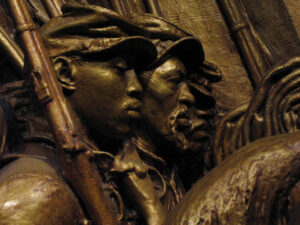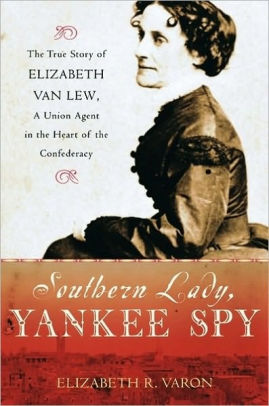
Detail from a statute to the famed 54th Massachusetts Regiment, U.S.C.T. and its commander, Robert Gould Shaw.
Yes! Where can I donate? Richmond Councilwoman Kim Grey’s proposal in this morning’s Richmond Times-Dispatch for a statute honoring the Civil War’s black Union troops from Virginia needs to be acted on promptly. It should replace the one statue that does need to disappear off Monument Avenue, the one to Jefferson Davis.
In particular the proposal focuses on 14 Medal of Honor winners, seven Virginians, from a September 1864 battle near New Market Heights, part of Grant’s slow strangulation by siege of the Rebel capital.
If the purpose of the existing statues to the Secesh generals is history, then the full history need be told, the victor’s history. Tens of thousands of Virginians white and black remained loyal to the Union, passively or even actively opposing the Confederate government. A good example was Elizabeth Van Lew, a Church Hill matron whose exploits are reconstructed in “Southern Lady, Yankee Spy,” by Elizabeth Varon. The description of postwar Richmond politics is just as interesting.
 Is there a plaque for Van Lew and her efforts anywhere in town? I’ve always wanted a statue to George H. Thomas, too, perhaps the highest-ranking Virginian in the Union Army at the end of the war, although he served mainly in western campaigns.
Is there a plaque for Van Lew and her efforts anywhere in town? I’ve always wanted a statue to George H. Thomas, too, perhaps the highest-ranking Virginian in the Union Army at the end of the war, although he served mainly in western campaigns.
In the checkout line at Lowe’s yesterday I struck up a conversation with a man who commented on my sweatshirt with an Air Force theme. It turned out his father had been a Tuskegee Airman, in the bomber squadron rather than the more famed fighter unit. All Americans should take pride in the accomplishments of those airmen. More Americans desperately need to understand that free and enslaved persons of African heritage have been crucial to this country’s military success since the Revolution.
They were never more essential than in the War of the Rebellion (which is what they call The War of Northern Aggression in states to the north.) Absent their service and sacrifice, the Union might have been dissolved after all.
The 2020 General Assembly will have to address whether to grant localities full control over the war memorials on their public sites, and what to do with the locations under full state control. The Lee Statue on Monument is state property, but the most obvious state-sponsored shrine to the Lost Cause resides in the old House Chamber of the State Capitol itself.
The memorials that I might stand in front of a bulldozer to protect are those to the common citizen-soldiers, the poor men in that rich man’s fight with their names listed outside county courthouses and city halls. They were not the political leadership which must take the blame for America’s most tragic war, and many were hardly volunteers.
Erase history? No. Show the full context and honor the Virginians on both sides. That is an easy yes. It was telling that the artist behind the new “Rumors of War” statue at the Virginia Museum of Fine Arts has come out against removing the Confederate statutes he was imitating (and gently mocking.) I suspect once the General Assembly does punt the issue to localities, the debate in Richmond will be more nuanced than you’d expect.


